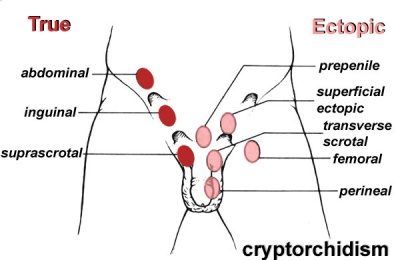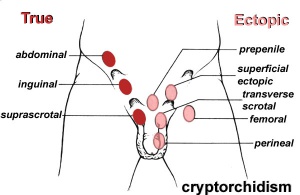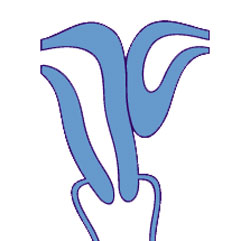Genital System - Abnormalities
Introduction
How and why do things go wrong in development? Human genital abnormalities are currently described as "Disorders of Sex Development" (DSD) and includes: chromosomal, gonadal dysfunction, tract abnormalities, external genitalia and gonadal descent.
Note, the earlier term "intersex" and a variety of other previously applied terms related to genetic abnormalities have been replaced by the term "disorders of sex development" (DSD).
| Abnormality Links: abnormal development | abnormal genetic | abnormal environmental | Unknown | teratogens | ectopic pregnancy | cardiovascular abnormalities | coelom abnormalities | endocrine abnormalities | gastrointestinal abnormalities | genital abnormalities | head abnormalities | integumentary abnormalities | musculoskeletal abnormalities | limb abnormalities | neural abnormalities | neural crest abnormalities | placenta abnormalities | renal abnormalities | respiratory abnormalities | hearing abnormalities | vision abnormalities | twinning | Developmental Origins of Health and Disease | ICD-11 | ||
|
Some Recent Findings
- The European Disorder of Sex Development Registry: A Virtual Research Environment.[1] "The EU-funded EuroDSD programme (www.eurodsd.eu) is one such collaboration involving clinical centres and clinical and genetic experts across Europe. At the heart of the EuroDSD collaboration is a European DSD registry and a targeted virtual research environment (VRE) that supports the sharing of DSD data."
- Low testosterone levels in pre-term newborns born small for gestational age.[2] "Previous studies showed that small for gestational age (SGA) newborns have an increased prevalence of hypospadias and other congenital defects of external genitalia. We observed that in the first days of life, SGA male pre-term newborns have reduced testosterone levels compared with adequate for gestational age pre-term newborns, independently from the presence of abnormalities of the external genitalia."
Congenital adrenal hyperplasia
- impairment of cortisol production by the adrenal cortex, is one of the most common causes of intersex genitalia at birth
- genetically male (XY) infants born with undervirilized genitalia (androgen insensitivity syndrome, cloacal exstrophy) are generally assigned and reared as girls.
Cryptorchidism
- abnormality of either unilateral or bilateral testicular descent, occurring in up to 30% premature and 3-4% term males.
- Descent may complete postnatally in the first year, failure to descend can result in sterility.
Testis descent is thought to have 2 phases:
- transabdominal descent - dependent on insulin-like hormone 3 (INSL3).
- inguinoscrotal descent - dependent on androgens.
Management of cryptorchidism in children: guidelines.[3] "Cryptorchidism is best diagnosed clinically, and treated by surgical orchiopexy at age 6-12 months, without a routine biopsy. If no testis is palpable, or if other signs of hypovirilisation such as hypospadias are present, the chromosomal sex and hormonal status must be assessed. Laparoscopy is the best way of diagnosing and managing intra-abdominal testes."
Undescended Ovaries
- reasonably rare gonad abnormality, often detected following clinical assessment of fertility problems and may also be associated with other uterine malformations (unicornuate uterus).
- Due to the relative positions of the male (external) and female (internal) gonads and the pathways for their movement, failure of gonad descent is more apparent and common in male cryptorchidism than female undescended ovaries.
Hydrocele
- Male Hydrocele is a fluid-filled cavity of either testis or spermatic cord, where peritoneal fluid passes into a patent processus vaginalis.
- Female Hydrocele is a similar, but rarer, fluid-filled cavity occuring in the female as a pouch of peritoneum extending into the labium majorum (canal of Nuck).
Tract Abnormalities
Many different forms
- Uterine: associated with other anomolies, unicornuate uterus
- Vagina: agenesis, atresia
- Ductus Deferens: Unilateral or bilateral absence, failure of mesonephric duct to differentiate
Uterine Duplication (uterus didelphys, double uterus, uterus didelphis) A rare uterine developmental abnormality where the paramesonephric ducts (Mullerian ducts) completely fail to fuse generating two separate uterus parts each connected to the cervix and having an ovary each.
Septate Uterus
Cervical: cervical agenesis, cervical duplication
Vaginal: Mayer-Rokitansky syndrome (MRK anomaly, Rokitansky-Küster-Hauser syndrome, RKH syndrome, RKH) congenital absence of the vagina, dyspareunia, vaginal agenesis.
Polycystic Ovary Syndrome
(PCOS) or Stein–Leventhal syndrome (1930s researchers) a metabolic syndrome with many other symptoms, ovarian cysts arise through incomplete follicular development or failure of ovulation. For review see [4]
Hypospadia
Hypospadias are the most common penis abnormality (1 in 300) and result from a failure of male urogenital folds to fuse in various regions. This in turn leads to resulting in a proximally displaced urethral meatus. The cause is unknown, but suggested to involve many factors either indivdually or in combination including: familial inheritance, low birth weight, assisted reproductive technology, advanced maternal age, paternal subfertility and endocrine-disrupting chemicals.[5] Infants with hypospadias should not undergo circumcision.
Hypospadia is classified by the location of the opening (meatus).
- Anterior - on inferior surface of glans penis.
- Coronal - in balanopenile furrow.
- Distal - on distal third of shaft.
- Penoscrotal - at base of shaft in front of scrotum.
- Scrotal - on scrotum or between the genital swellings.
- Perineal - behind scrotum or genital swellings.
Surgical Repair - Depending on the class of hypospadias there are a number of different surgical repair techniques including: orthoplasty or penile straightening, urethroplasty, meatoplasty and glanuloplasty, scrotoplasty (oscheoplasty) and skin coverage.
Links: Genital Abnormality - Hypospadia
Related Genetic Conditions
- Johanson-Blizzard syndrome[6] - hypospadias, failure to thrive, exocrine pancreatic deficiency, short stature and developmental delay, cutis aplasia on the scalp, aplasia of alae nasi, hypothyroidism, myxomatous mitral valve, and patent ductus arteriosus.
References
Reviews
Articles
Search Pubmed
Search Pubmed: Genital System Abnormalities | Disorders of Sex Development | Hypospadia
External Links
Glossary Links
- Glossary: A | B | C | D | E | F | G | H | I | J | K | L | M | N | O | P | Q | R | S | T | U | V | W | X | Y | Z | Numbers | Symbols | Term Link
Cite this page: Hill, M.A. (2024, April 27) Embryology Genital System - Abnormalities. Retrieved from https://embryology.med.unsw.edu.au/embryology/index.php/Genital_System_-_Abnormalities
- © Dr Mark Hill 2024, UNSW Embryology ISBN: 978 0 7334 2609 4 - UNSW CRICOS Provider Code No. 00098G




